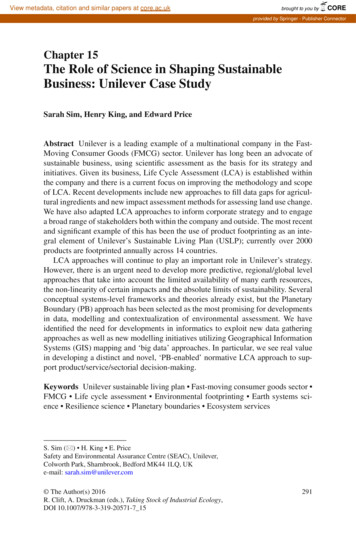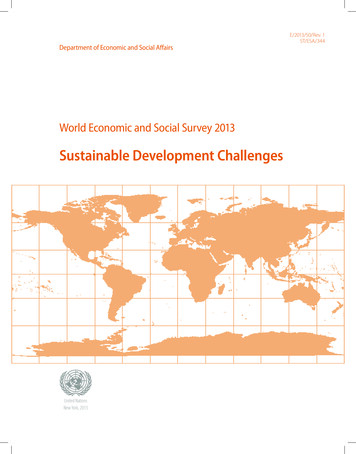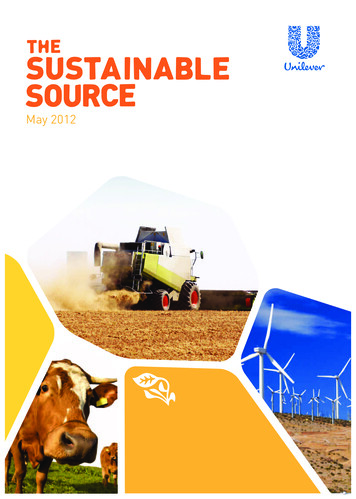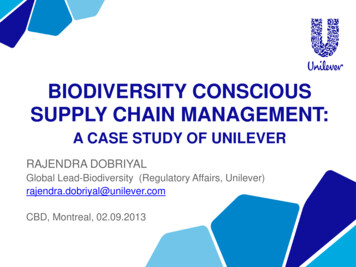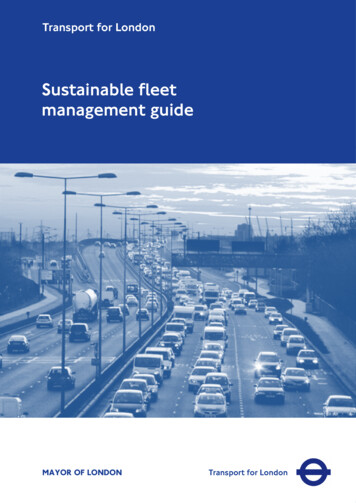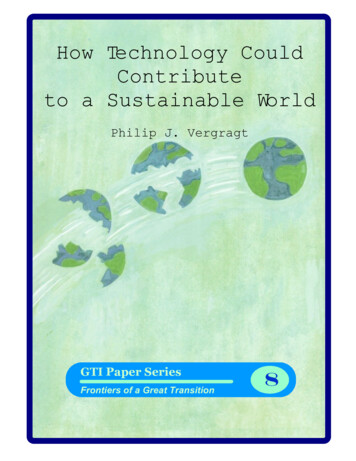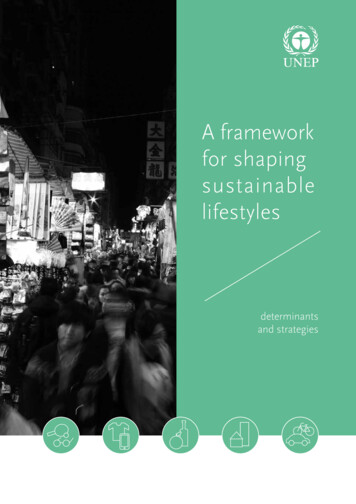
Transcription
A frameworkfor shapingsustainablelifestylesdeterminantsand strategies
AcknowledgementsAuthors:Lewis Akenji (IGES),Huizhen ChenContributors:Garrette Clark (UN Environment),Stefanos Fotiou (UN ESCAP),Mari Nishimura (UN Environment)Reviewers:We would like to thank the following for their valuable technical inputs:Midori Aoyagi (National Institute for Environmental Studies),Julian Borra (ThinAirFactory), Kate Burningham (University of Surrey),Maite Cortés (Colectivo Ecologista Jalisco), Gunilla Elsasser (WWF),Maria Ghiso (Rainforest Alliance), Bronwyn Hayward (University of Canterbury),Tim Jackson (University of Surrey), Vimlendu Kumar JHA (Swechha India),Michael Lettenmeier (D-mat), Nguyen Hong Long (GetGreen Vietnam),Charlie Mathews (JUCCCE), Zipporah Musyoki-Webola (WWF),Kenneth Ochoa (Universidad El Bosque), Peter Repinski (Stockholm EnvironmentInstitute), Ingrid Joan Schudel (Rhodes University), Burcu Tuncer (SWITCH-Med),and UN Environment (Khairoon Abbas, Kamala Ernest, Bettina Heller,Arab Hoballah, Rob de Jong, James Lomax, Llorenç Milà i Canals, Martina Otto,Liazzat Rabbiosi, Helena Rey de Assis, Janet Salem, Steven Stone, Elisa Tonda,and Adriana Zacarias).Concept of Figures:Design:Cover Photo:Back Photo:Jeremy BlanksViola Kup (UN Environment)Hong Kong Market Yusuke NishimuraSmiling Youth Jerome Sessini/ Magnum Photos for UN EnvironmentDTI/1717/PA United Nations Environment Programme, 2016This publication may be reproduced in whole or in part and in any form for educational or non-profitpurposes without special permission from the copyright holder, provided acknowledgement of thesource is made. The United Nations Environment Programme would appreciate receiving a copy of anypublication that uses this publication as a source.No use of this publication may be made for resale or for any other commercial purpose whatsoeverwithout prior permission in writing from the United Nations Environment Programme.DisclaimerThe designations employed and the presentation of the material in this publication do not imply theexpression of any opinion whatsoever on the part of the United Nations Environment Programmeconcerning the legal status of any country, territory, city or area or of its authorities, or concerningdelimitation of its frontiers or boundaries. Moreover, the views expressed do not necessarily representthe decision or the stated policy of the United Nations Environment Programme, nor does citing of tradenames or commercial processes constitute endorsement.The contents of this report do not necessarily reflect the views or policies of UN Environment or theeditors, nor are they an official record. The designations employed and the presentation do not imply theexpressions of any opinion whatsoever on the part of UN Environment concerning the legal status of anycountry, territory or city or its authority or concerning the delimitation of its frontiers or boundaries.iiUN Environmentpromotes environmentally soundpractices globally and in itsown activities. This report is printed onpaper from sustainable forests includingrecycled fibre. The paper is chlorine free.Our distribution policy aims to reduceUN Environment’s carbon footprint.
A framework for shapingsustainable lifestylesdeterminants andstrategies
Table of ContentsPreface: Sustainable Lifestyles as an Engine for Change vi1Introduction 11.1 The need to promote sustainable lifestyles 21.2 Key lifestyles domains and the environment 6Food 6Housing 7Mobility 8Consumer goods 9Leisure 92Lifestyles in Context 112.1 Theoretical framing of lifestyles from a sustainability lens 122.2 Influencing factors of consumption and lifestyles 152.2.1 Motivations of lifestyles 162.2.2 Drivers of lifestyles 182.2.3 Determinants of lifestyles 223Developing strategies for sustainable lifestyles 253.1 Spurring bottom-up action: the Refuse, Effuse, Diffuse (REDuse) framework 263.2 The Attitude-Facilitators-Infrastructure (AFI) framework 303.2.1 Attitude – pro-sustainability value orientation 313.2.2 Facilitators/Access – institutional arrangements and enablers 323.2.3 Sustainability infrastructure – the hardware and systems of provision 334Concluding notes 37List of FiguresFigure 1:Figure 2:Figure 3:Figure 4:Figure 5:Figure 6:Figure 7:Figure 8:Figure 9:Figure 10:Lifestyle aspects and the food supply chain 6Lifestyle aspects and the housing supply chain 7Lifestyle aspects and the mobility supply chain 8The ring of lifestyles: layers of influence on needs and wants 19Factors influencing of sustainable lifestyles 23The REDuse (Refuse-Effuse-Diffuse) framework for sustainable lifestyles 28Key elements of policy design to enable sustainable lifestyles 30Stakeholder attitudes as a pre-condition for sustainable lifestyles 31Facilitators of sustainable lifestyles 32Sustainable infrastructure as a pre-condition for sustainable lifestyles 33List of TablesTable 1:Table 2:Table 3:Examples of REDuse actions by consumers in high-impact consumption domains 29Examples of use of AFI to address key sustainable lifestyle objectives 34Sample AFI worksheet to assess sustainability action for key domainsof consumption 34v
Preface:SustainableLifestyles asan Engine forChangeHumans make hundreds of thousands of decisionsduring the course of their lives. For the lucky amongus, those decisions will vary wildly. What food will Ieat? what house will I live in? How will I get to workin the morning? What type of clothes will I wear?How will I spend my spare time? The list is endless.No matter how we choose to answer thesequestions, the lifestyles we end up living – or, insome cases, are forced to live – have a profoundimpact on our planet, affecting everything from howour economies grow to the health of ourenvironment.Our consumption habits are putting our resourceslevels at great risk. The amount of stuff we use inorder to live has exploded in many parts of the world,highlighted by the fact that the global extraction ofmaterials has tripled over the past four decades,rising to an enormous 70 billion tonnes in 2010. Ifcurrent trends continue, then this dramatic increasein the amount of material we consume will continueto rise as populations grow, the middle classexpands, and incomes increase.Today, cities are associated with 60 to 80 per cent ofall greenhouse gas emissions, consume 75 per centof natural resources, and account for 50 per cent ofall waste (UNEP, 2012). By 2050, the number ofpeople living in urban areas is expected to reach 6.3billion – roughly two-thirds of the global population.This will have a profound effect on what and howindividuals and societies consume, especially when itcomes to food, mobility, housing, consumer goodsand leisure.As a result, this urban shift carries with it immensesocial implications. The extra pressure these newurban consumers will place on the world’sincreasingly scarce resources will exacerbate existingtensions between the world’s wealthiest 10 per cent,whose lifestyles contribute half of global carbonemissions, and the growing numbers of urban poor,who are responsible for only 10 per cent of carbonemissions (Oxfam, 2015).If current trends continue, by 2030, humanity willneed the equivalent of two Earths to support itself,according to some experts. This is clearly not viablein a world where climate change will make it evenharder for the natural world to provide for our needs.There are encouraging signs that society is beginningto understand the impact of our daily choices. Termslike “quality of life” and “sustainable lifestyles”regularly appear in the media, illustrating that peopleare already weaving sustainability into their dailyvi
decision-making. Carbon footprinting, food wastereduction campaigns, urban gardening, vehiclesharing models, and surveys to understand the valuesand motivations of youth are all ways that are helpingpeople to live more sustainable lifestyles.Yet these actions, in general, are piecemeal. Theyare not yet framed within a holistic vision of whatconstitutes a sustainable lifestyle. Living sustainablyis not just about individual choice: it is also aboutensuring that governments and businesses enactpolicies that guide people towards these type oflifestyles. Often ignored is the role that public sectorinstitutions can play in shaping better policy and therole of businesses in providing more sustainablegoods and services.Fortunately, sustainable lifestyles are now solidlyanchored in policy. The COP21 Paris Agreement madeit clear that sustainable lifestyles and sustainablepatterns of consumption and production (SCP)will be key in the fight against climate change. Thegoals set out in the 2030 Agenda for SustainableDevelopment and intergovernmental processeslike the 10 Year Framework of Programmes on SCPgive further support to champions of sustainablelifestyles by acknowledging the powerful role theycan play in lifting people out of poverty, endinghunger, and reducing inequality while protecting theenvironment. At least two of the eight themes at theWorld Economic Forum 2016 in Davos, Switzerland,highlighted the impacts of climate change on ourlives and the effects of increasing wealth inequalityon economic development. This clearly shows thatsustainable consumption and lifestyles are growing inimportance on the international stage.With this solid foundation in place, it is now time todevelop a more structured, life-cycle, and evidencebased understanding of sustainable lifestyles tofacilitate global dialogue and measure progress. Thiswill enable us to focus on the ‘hotspots’ on wherecritical action can be taken.sustainability performance to enhance informeddecision-making.This publication contributes to this understanding.It reviews the current knowledge about what factorsinfluence lifestyles and proposes strategies forassessing policies and developing necessary actions.The Refuse, Effuse, Diffuse (REDuse) framework, forexample, facilitates individual actions and bottom-upinitiatives. The Attitudes-Facilitators-Infrastructure(AFI) framework enables policymakers to assesspolicies and initiatives to develop sustainablelifestyles policies. Worksheets and examples illustratehow these approaches can be used to improvedecisions related to the core lifestyle areas of food,mobility, housing, consumer goods and leisure.We hope it will help policymakers, individuals,and other stakeholders understand what a holisticapproach to lifestyle means and how differentcontexts require different lifestyle solutions.Sustainability is relative and it varies depending ongeography and local conditions. As a result, thispublication does not set out to define what “the”sustainable lifestyle looks like. Instead, it can helpguide a range of initiatives that enable lifestylechoices that contribute to sustainability.Simply put, if current trends continue, then theevidence says that there are not enough resourcesto meet the demands of consumers. So the vitalquestion is: how can the way we live our lives –the hundreds of decisions we make every day asindividuals and policymakers – be transformed intolifestyles that are sustainable? This publication is anevidence-based framework designed to engage in thisdialogue.Arab HoballahFor individuals, this means understanding theimpacts of their daily decisions and embracingmore sustainable lifestyles. For governments, itimplies setting a conducive regulatory context,facilitating and inspiring better citizen decisionmaking, creating market demand throughsustainable public procurement, and supportingresearch, development, and innovation. For theprivate sector, it implies integrating sustainabilityinto core business strategies to develop innovativeways to meet the needs of people while reducingthe pressure on the world’s dwindling resources.This includes communicating about productvii
CC BY-NC Sam Gaoviii
Introduction1
1.1The need topromotesustainablelifestylesLifestyles are social prints of how we live – they guideour habits, frame our behavioural and consumptionchoices, shape our identity, influence our health, andwelcome or exclude us from social relationships.Everyone has a lifestyle, and yet lifestyles remainchallenging to understand systemically and to directlyaddress in the context of social transformation.Still, there is ample evidence that lifestyles can beinfluenced and that they change.If our lifestyles shape our behavioural patterns, thenfrom a sustainability perspective, lifestyles also defineour footprint. Everyone has a responsibility to delivera better human society and a better planet to futuregenerations. This responsibility is operationalizedthrough our preferences and the choices we make.As individuals and households, how we live – how weexercise our pursuit of well-being and happiness –affects others and has an impact on the environment.On the community or institutional level, governmentsare responsible for policies and initiatives that framethe societal context in which people, householdsand communities operate. Businesses, and the valuechains they comprise, have a responsibility throughtheir operations and the goods and services theyoffer. Each and every one of us has an impact on theworld. Thus sustainable lifestyles are essential to ourpursuit of happiness and at the heart of sustainabledevelopment.Discussions around lifestyles are age old. Fromthe beginning of civilization, among ancient Greekand Chinese philosophers, to today, among theecological and behavioural scientists, many effortshave been made to define the essence of “the goodlife.” Thornstein Veblen (1902) in The Theory of theLeisure Class was an early influence in the studyof material consumption. He linked the underlyingmotive of “conspicuous consumption” to expressionsof identity – a display of social status where peopleseek to affiliate with or differentiate from others andto differentiate between membership in a superior“leisure class” and the wider majority of those in thelabour classes. This is different from “inconspicuousconsumption” – ordinary everyday consumption, notoriented toward display but rather meeting needs,convenience, habit, practice, and social norms.In the 21st century, the discussion has acquired newcomplexities as globalization results in value chainsthat span the earth and changes in communicationand information technologies have made the worlda smaller, more interconnected place. Though manypeople are better off, there are increasing socialinequalities (across and within countries) and globalecological trends which threaten the ability to meetall human needs and the stability of our intertwinedsocieties, and which test planetary boundaries.2
Box 1degradation and global warming, and calls on allpeople of the world to take swift and unified globalaction.Evidence qualifying impacts of lifestyles onsustainable development is mounting. By 2050,without radical changes in production-consumption1IntroductionThere is now recognition that current consumption,defined by lifestyles, is one of the underlying driversof unsustainable trends. His Holiness Pope Francisis only one of the most recent public leaders whohave directly addressed consumption. His encyclical(Pope Francis, 2015) criticizes consumerism andirresponsible development, laments environmentalWhat is a sustainablelifestyle?A definition of sustainable lifestyles should address the role of materialconsumption as well as the broader context within which lifestyles occur –acknowledging people’s aspirations for happiness, recognizing the ecologicaland material limits to meet demands, and the interdependence among peoplein a shared consumption space. This publication uses the following definition:A “sustainable lifestyle” is a cluster of habits and patternsof behaviour embedded in a society and facilitatedby institutions, norms and infrastructures that frameindividual choice, in order to minimize the use of naturalresources and generation of wastes, while supportingfairness and prosperity for all.Creating sustainable lifestyles requires a change in social norms and in thedesign of the systems that support lifestyles. It means rethinking our waysof living – including how we buy and organize our everyday lives. There arealso implications for how we socialize, exchange, share, educate, and developour identities. At the macro level, it is about transforming societies to bettermeet people’s needs in balance with the natural environment. As citizens, athome and at work, the choices we make on food, housing, mobility, consumergoods (including clothes and appliances, etc.), leisure (including tourismproducts and services), communication, and interaction contribute to buildingsustainable lifestyles.(This is an updated definition based on UNEP (2010), the Taskforce on SustainableLifestyles (Sweden, n.d.), and recent research as referenced in this publication.)3
systems, three planets’ worth of resources will berequired to support projected consumption levels(Global Footprint Network, n.d.). For transformativechange, interventions should target the mostinfluential lifestyles, those with the highest impactson the environment and those which drive globalaspirations. This publication targets these middleclass urban lifestyles, the largest consuming segmentof people in industrialized regions and increasinglyin all other regions. While the environmental impactsof highly consumptive, unsustainable lifestyles ofindustrialized countries are well documented, moreneeds to be done to address their influence onemerging regions. This influence is strengthenedby upholding the North American and European“dream” which continues to define appetites of thenew urban middle-class everywhere.CC BY-NC Ilja SmetsThe global middle class is anticipated to grow from1.8 billion to 4.9 billion in population between nowand 2030 (Kharas, 2011) and the vast majority of thiswill be youth and will live in Asia, though many otherswill live in burgeoning urban environments in Africaand Latin America. It is estimated that between 2009and 2030 the global middle class demand could growfrom US 21 trillion to US 56 trillion (Ernst & Young,2011). They will be increasingly ready to spend asthey aspire (and set aspirations for others) to a higherquality of life. Hence, as well as addressing lifestylesof industrialized societies, targeting the middle classof emerging economies will play a significant role inensuring the sustainability of the planet. The globalpolicy agenda now specifically references sustainablelifestyles, as evidenced by the Paris Climate ChangeAgreement and the recently adopted SustainableDevelopment Goals (SDGs). Goal 12.8 sets thetarget: “By 2030 ensure that people everywherehave the relevant information and awareness forsustainable development and lifestyles in harmonywith nature.”4
Key lifestylesdomainsand theenvironment1Introduction1.2Given that consumption is heavily embedded inlifestyles, researchers have been able to identify keydomains where consumption and lifestyles have thehighest environmental impacts by combining anunderstanding of consumption patterns, life-cycleanalysis and sustainability indicators for carbon,material, and ecological footprinting. For example,the International Resource Panel (IRP) produced asynthesis report (Hertwich, van der Voet, & Tukker,2010) with a global assessment of final consumptioncategories and product groups that have the highestenvironmental impacts across their life cycle. Thetop three impact categories are food and agriculture,housing and building construction, and mobility andtransportation. Other studies which focus on national(e.g.: Lettenmeier, Liedtke, & Rohn, 2014; Michaelis &Lorek, 2004) and regional (Backhaus, Breukers, Mont,Paukovic, & Mourik, n.d.; EEA, 2012; OECD, 2002) levelsdraw similar conclusions. In addition they all highlightthe large footprints of consumer products and services,including those related to tourism and entertainment.There are, however, limitations to relying only onfootprint calculations for policy design and action.These include: problems with data, the number ofindividual product life cycles that would need tobe analysed to provide a comprehensive impactassessment, and the fact that most assessmentscarried out reflect consumption in industrializedcountries and regions. For a broader picture oflifestyle impacts, quantitative methods (such asfootprint analysis) need to be complemented withnormative, qualitative assessments, especiallyin the case of emerging economies. This reporthighlights that sustainable lifestyles imply morethan material consumption alone. Beyond justenvironmental impacts, the social impacts oflifestyles and consumption can be equally or evenmore problematic.For the purposes of developing research-based,practical strategies and responsive interventionstowards sustainable lifestyles, the key domainsof final consumption highlighted in this reportare: food, housing, mobility, consumer goods andleisure. Water, energy, and waste are not addressedin isolation but as cross-cutting elements that affectand are affected by almost every lifestyle domain. Theemerging practice of hotspot analysis to highlightwhere action could be taken along supply chainsand potential impacts, though not covered in thisreport, is instrumental in the next steps (Barthelet al., 2014; Tukker et al., 2006; UNEP, 2010b).Similarly, understanding the political economy aroundconsumption and the power dynamics in the supplychain would further highlight which stakeholder(s)has the most potential for sustainability.5
Food.factors that have impacts on the environment includeoutlet of purchase, storage period and facilities,preparation process, and consumption. Apart fromenvironmental impacts, concerns around lifestyles andfood include health, obesity, an increasing numberand intensity of allergies, and social impacts ofagricultural practices. Globally, almost a third of foodharvested is wasted or lost; contributing to this arechanging dietary trends, particularly in urbanenvironments which increasingly favor more resourceintensive (GHG producing) foods such as processedfoods and meats. This occurs in a global contextwhere 1 in 9 people are hungry and 2 in 10 are obese.There is clearly potential to shift to more sustainablepatterns. Cities can encourage more sustainable dietsthat ensure adequate nutrition while reducingenvironmental footprint, raising awareness, andchanging behaviour around food waste. Enactingpolicies in planning, housing and transportation canalso support more sustainable low carbon foodsystems and encourage more sustainable local foodproduction such as backyard and community gardens.What we eat and drink –how it is produced, processedand provided – and how wedispose of it all have impactson the environment andsociety.INPUTSPeople make decisions related to food based on bothobjective and subjective factors, including cost,freshness, health impacts, presentation (e.g.,packaging), place of origin, convenience, taste, andculture. At the use phase in the food system, someLAND USEENERGYWATERHEALTHCONVENIENCEOUTPUTSPOST- INGAIR POLLUTION (GHG)CHEMICALS/POLLUTANTSLAND FRAGMENTATIONSOLID WASTEFigure 1: Lifestyle aspects andthe food supply chain
How we live, where we live,what is used to build, heatand cool our living spacesand what we install in ourhouses have social andenvironmental impacts.INPUTSThe building sector contributes up to 30 per cent ofglobal annual greenhouse gas emissions and usesup to 40% of all energy (UNEP, 2009). In order toaddress this, we need innovative solutions on whatfuture buildings and cities will look like. BuildingLAND USEMINERALS & METALSNATURAL RESOURCESconstruction requires resources such as sand, woodand metals. Many of the materials require preprocessing and some of them are sourced throughmining. The mining process alone causes biodiversityloss, deforestation, emissions of GHGs and useof hazardous chemicals. People make decisionsrelated to housing based on both objective andsubjective factors, including cost and size of thebuilding, building characteristics, aesthetics, theneighbourhood, and available amenities. While livingin houses we use energy and water, and disposeof waste: important energy considerations includeefficiency insulation and heating and/or cooling. Theway neighbourhoods are built affects many aspectsof society, including the rate of crime, commutingdistances, the opportunities for neighbours to createstrong ties and form vibrant communities and thegeneral well-being of inhabitants. Finally, at theend of a house’s life cycle, the building needs to bedemolished, requiring energy and producing UTPUTSPOST- GINSULATIONRENOVATIONRECYCLINGDEMOLITIONAIR POLLUTION (GHG)LAND FRAGMENTATIONSOLID WASTESEWAGEFigure 2: Lifestyle aspects andthe housing supply chain7
Mobility.What forms of transport wechoose, how often we travel,and the distance travelledas well as the supportingsystems and infrastructurehave impacts on society andthe environment.INPUTSThe transport sector is responsible for 13 per cent ofgreenhouse gas emissions and 23% of CO2 emissionsfrom global energy consumption (GEF-STAP, 2010).Citizens make mobility decisions based on cost, choiceLAND USEFOSSIL FUELSMINERALS & METALSOTHER NATURALRESOURCESof transportation mode, congestion, convenience, timeefficiency, connectedness, and environmental impacts.Mode of transportation is particularly significant –flying tends to have the highest environmental impact,followed by private car use. Other factors, such asdistance covered, number of people in the vehicle peruse, technology efficiency, and type of fuel used alsocontribute substantially. Awareness of climate changehas led to increased understanding of mobility impactson society and the environment. However, more canbe done to understand how people’s mobility needscan be addressed in a more sustainable way. Part ofthis involves questioning the need for mobility in givensituations, and in making living choices that requireless transportation (e.g. residential housingconfigurations that require less commuting and lesstravel for shopping and entertainment). For example,policy responses can include combinations ofmeasures that discourage unnecessary transportation,adopt more sustainable modes of transport, andimprove existing systems of TPUTSPOST- NCYACCESSCONVENIENCERECYCLINGDEMOLITIONAIR POLLUTION (GHG)WASTE WATERLAND FRAGMENTATIONSOLID WASTEFigure 3: Lifestyle aspects and themobility supply chain
The products we buy, the typeand quantity of materials thatare used in producing them,how we use them, and howoften we replace them haveimpacts on society and theenvironment.Examples include electric and electronic appliances,clothing and shoes, cosmetics and personal care,jewellery, furniture and paper products. Productswhich tend to have the highest impacts are thoseproduced using mined materials and fossil fuels.Consumer goods are important because of their dailyuse and their role in defining our image and habits.Leisure.How we spend leisuretime, our choice of tourismdestinations and activities,and the facilities we use havesignificant contributions tothe environment and society.Leisure embodies a wide variety of activities– from meditation and reading to flying andwatching television; or swimming, golfing,1IntroductionConsumergoods.The expanding role in modern lifestyles of electric andelectronic products (e.g. mobile phones and otherinformation communication products) means relatedenvironmental impacts are increasing, through thegrowth of electronic waste, pollution, and mining ofrare earth metals. However, they also have a strongpotential to unleash sustainability efforts because oftheir role in disseminating information and enhancingknowledge/experience exchange, and their globalreach.The fashion and textile industries have evolved toembrace a fast-fashion phenomenon, characterizedby tens of “micro-seasons” and some popular brandsintroducing hundreds of new styles a week. Forsome middle class consumers, clothes are rarely,if ever, worn and move quickly to landfills. Theseconsumption patterns have huge implications forresource scarcity and pollution, with impacts that varyaccording to fabrics, dyes, chemicals, tra
Fortunately, sustainable lifestyles are now solidly anchored in policy. The COP21 Paris Agreement made it clear that sustainable lifestyles and sustainable patterns of consumption and production (SCP) will be key in the fight against climate change. The goals set out in the 2030 Agenda for Sustain



